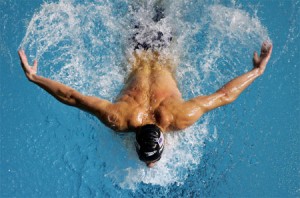 If you’re like most beginner triathletes, the swim can be your biggest challenge. Many triathletes approach their swim training with a certain amount of dread, looking at each workout as another battle with the black line of the bottom of the pool. Fortunately, with a little imagination and creativity, swimming can actually be one of the most fun sports to train for. I’ve been a swim coach for 15 years, and in that time I’ve worked with hundreds of swimmers ranging in ages from six months to seventy years. I’ve coached for big age group teams and summer league teams where I’ve had to fill 4 hours of practice time every day, and anyone who’s tried to keep 120 kids busy for 4 hours a day knows that you’ve got to get creative! There are so many variables to work with in swim training that you can come up with endless possibilities for workouts. The main variables are equipment, intervals, strokes, and drills. I’m going to discuss the first one today, and I will delve into the others in future posts.
If you’re like most beginner triathletes, the swim can be your biggest challenge. Many triathletes approach their swim training with a certain amount of dread, looking at each workout as another battle with the black line of the bottom of the pool. Fortunately, with a little imagination and creativity, swimming can actually be one of the most fun sports to train for. I’ve been a swim coach for 15 years, and in that time I’ve worked with hundreds of swimmers ranging in ages from six months to seventy years. I’ve coached for big age group teams and summer league teams where I’ve had to fill 4 hours of practice time every day, and anyone who’s tried to keep 120 kids busy for 4 hours a day knows that you’ve got to get creative! There are so many variables to work with in swim training that you can come up with endless possibilities for workouts. The main variables are equipment, intervals, strokes, and drills. I’m going to discuss the first one today, and I will delve into the others in future posts.
There are several essential pieces of equipment that each swimmer should own: a kickboard, a pull buoy, two sets of hand paddles, a pair of fins, and an ankle band. There are many, many other items out there, and they all have their uses, but there are the core items that you should take to the pool for every swim. I suggest getting a mesh equipment bag to keep all your gear together. Here’s a bit more about each different item:
Swim Training Triathlon Tips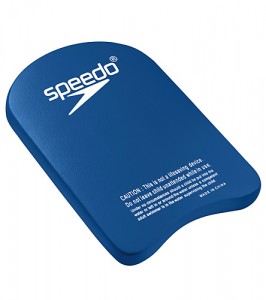
Kickboard: If you want to become a better swimmer, the first step is to become a better kicker, so grab your kickboard and get to work! You should spend up to 20% of each practice working on your kick. The right way to do it is to keep your body straight and tall, hold your kickboard with both arms and keep them extended straight out in front of your body with the board flat on the surface of the water. The amplitude of your kick should be small, just wider than the width of your body, and your heels should just barely brush the surface of the water. Kick fast enough that you make the water boil, but don’t make a huge splash, that just means that you’re kicking air. Start with manageable distances, if you can only maintain your form for a 25, then start with 6-8×25 and build up from there. You don’t need to kick like you’re swimming the 50m freestyle in the Olympics, but a strong kick can boost your propulsion by 10-15%, and a solid kick is essential to maintaining balance and body position, and generating rotation.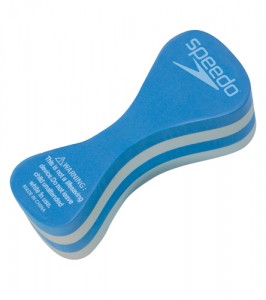
Pull Buoy: If most triathletes hate their kickboards, it’s also true that most of them love their pull buoys. However, this also makes the pull buoy the piece of equipment that is most often abused by triathletes. I’ve worked with athletes during their swim training who would physically resist anyone who tried to take their pull buoy away, claiming that it prepared them for wetsuit swims, while always maintaining that as a triathlete they didn’t really need to kick anyway. What really happens when you get too dependent on your pull buoy is that you don’t learn proper balance and body position, and you never develop a propulsive kick. The proper use of a pull buoy is to develop technique. The buoy puts your body in a more horizontal position in the water by keeping your hips high, and allows you to focus on the technique of your pull without distractions. Use a pull buoy sparingly, and only as an aid to developing proper technique, never as a crutch for a poor kick or an improper body position.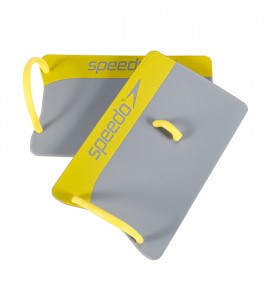
Hand Paddles: After pull buoys, hand paddles are probably the piece of equipment that gets abused the most. I have to come clean here and admit that hand paddles are my crutch of choice, and there’s been many times during swim training where I’ve been struggling to make the interval and reached for my hand paddles. I’ve caught my share of abuse from training partners over this! But when used properly, hand paddles are a great training tool. I recommend having two different sizes during swim training. Use a larger paddle for fast 25’s and 50’s to develop power and speed, select a smaller paddle for drills and technique work to help refine your pull and feel for the water.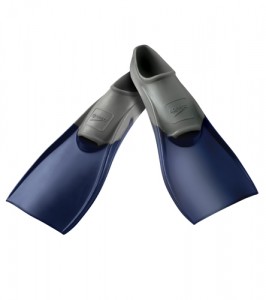
Fins: Fins are great for both building strength and developing technique. Getting the right size is important though, you don’t want giant fins meant for deep sea diving. Something like Finis Zoomers are about right for most athletes. Putting your fins on for a sprint set will give you the feeling of smooth and effortless speed in the water, something we’d all like to have all the time! Fins are also great for drill sets, where they allow you get the feeling of a strong, propulsive kick which helps you to generate rotation and maintain a high body position in the water. Fins help you to achieve the feeling that you’re striving for when you’re not wearing them. Just make sure that you use them sparingly and don’t let them become a crutch for faulty technique and balance.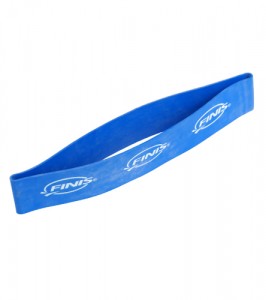
Ankle Bands: The final piece of equipment that you need is also the one that most people avoid. Swimming with an ankle band is tough! But triathlon swim training is as much about toughness and strength as it is about technique and efficiency, you’ve got to have the strength to power through whatever the swim throws at you. Doing some swims with ankle bands will help you build that power. My old swim training coach used to make ankle bands for us by cutting up old inner tubes, but you can get one that will look a little more presentable at masters practice by picking up a FINIS Pulling Ankle Band. Start out with some short repeats, you’ll be amazed how hard it is initially just to swim a 25 with an ankle band. You can also use a band and a buoy at first to help get comfortable. When you get to the point where you build up to some longer swim and can do 100’s and 200’s with a band, you’ll be amazed at the difference it will make in your open water swimming.
Triathlon Swim Training Closing
I hope that these triathlon swim training tips will help you to improve the quality and variety of your workouts. It’s easy so see that if you did a short set with each one of these pieces of equipment that you could make a couple of thousand yards go by pretty fast! And including these items in your workouts will also help you to improve your technique, build strength, and swim faster. I’ll be posting lots more information about triathlon training and equipment soon, so please watch this space for more beginner triathlon tips. Thanks for reading!



